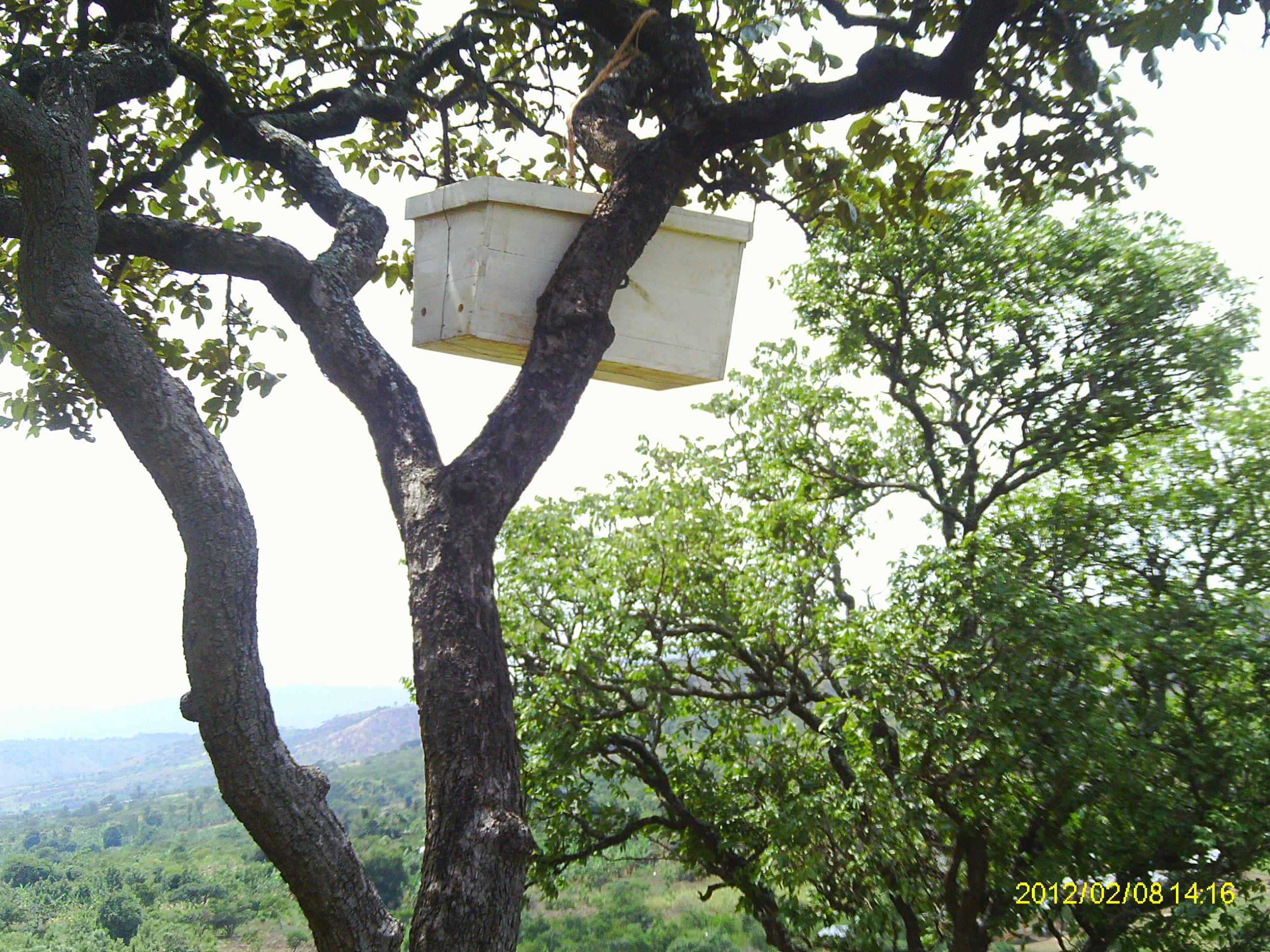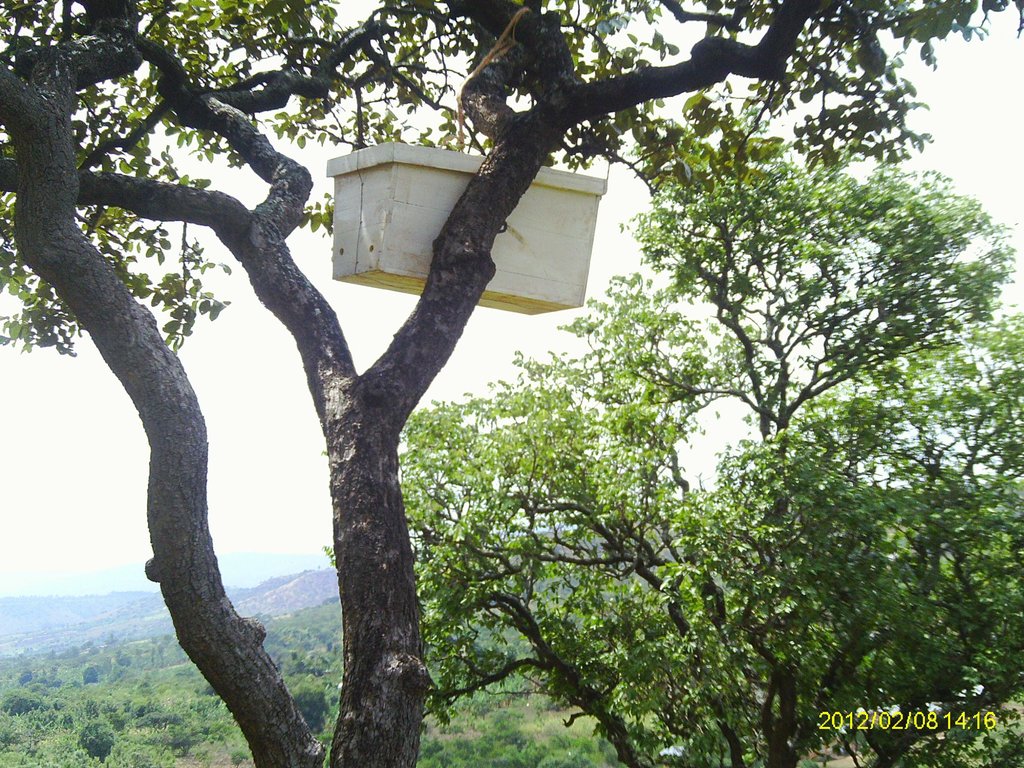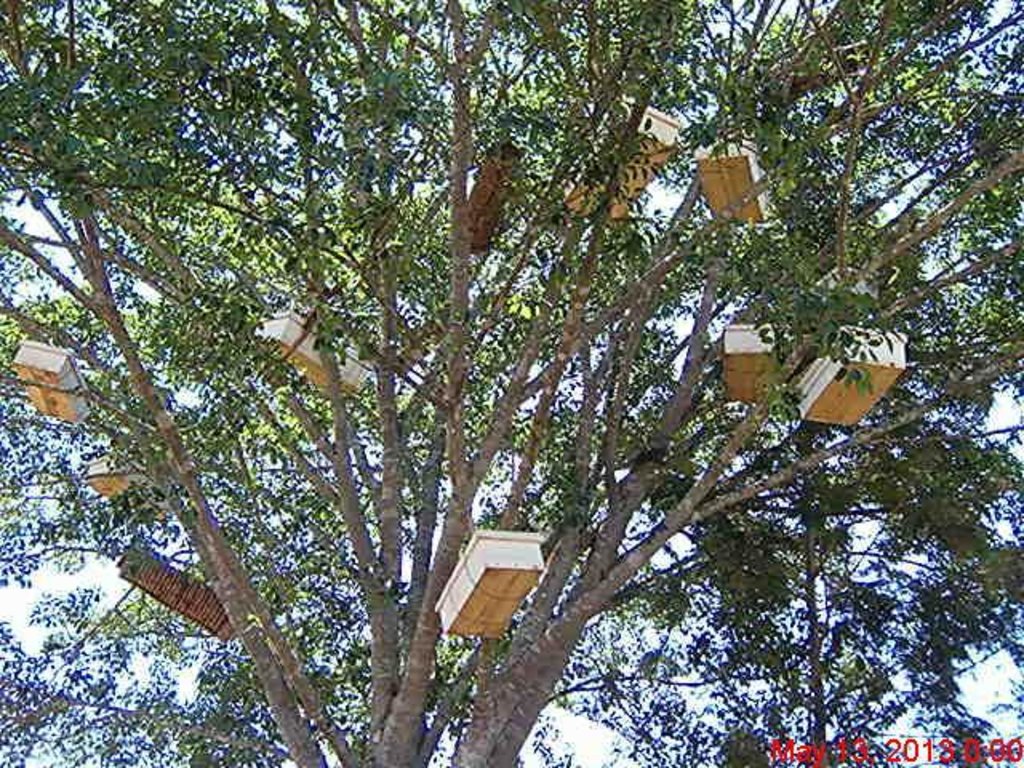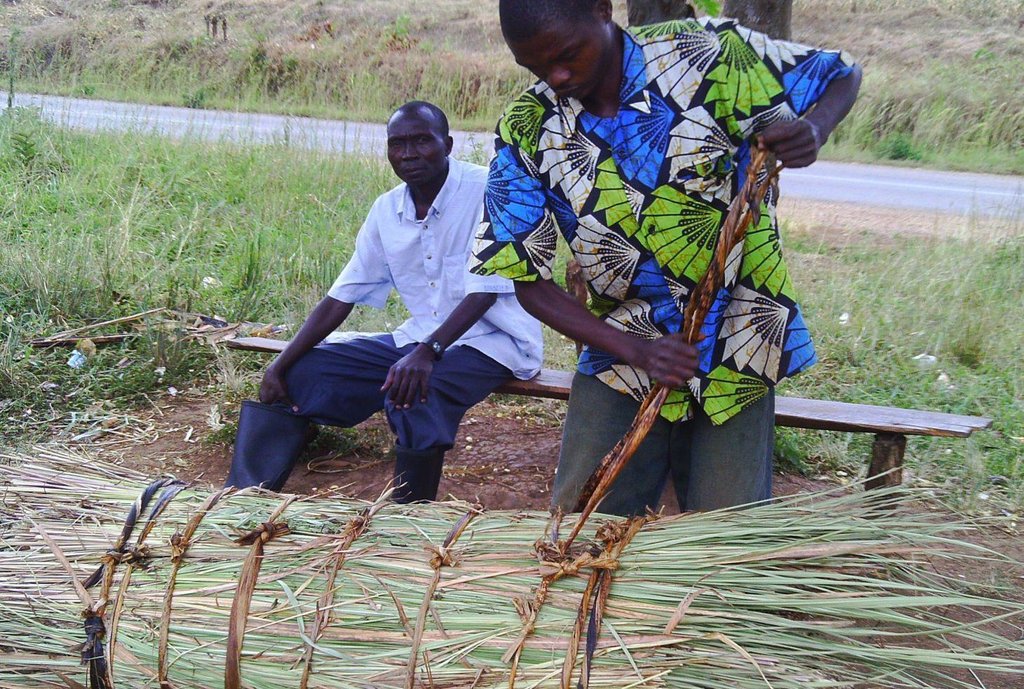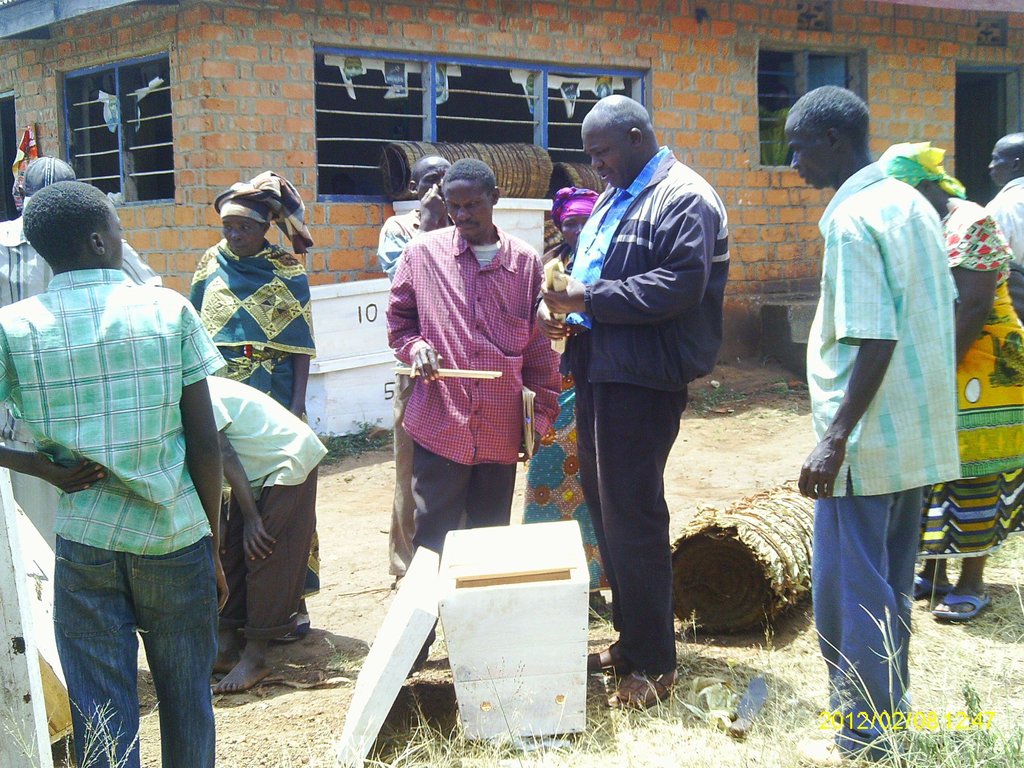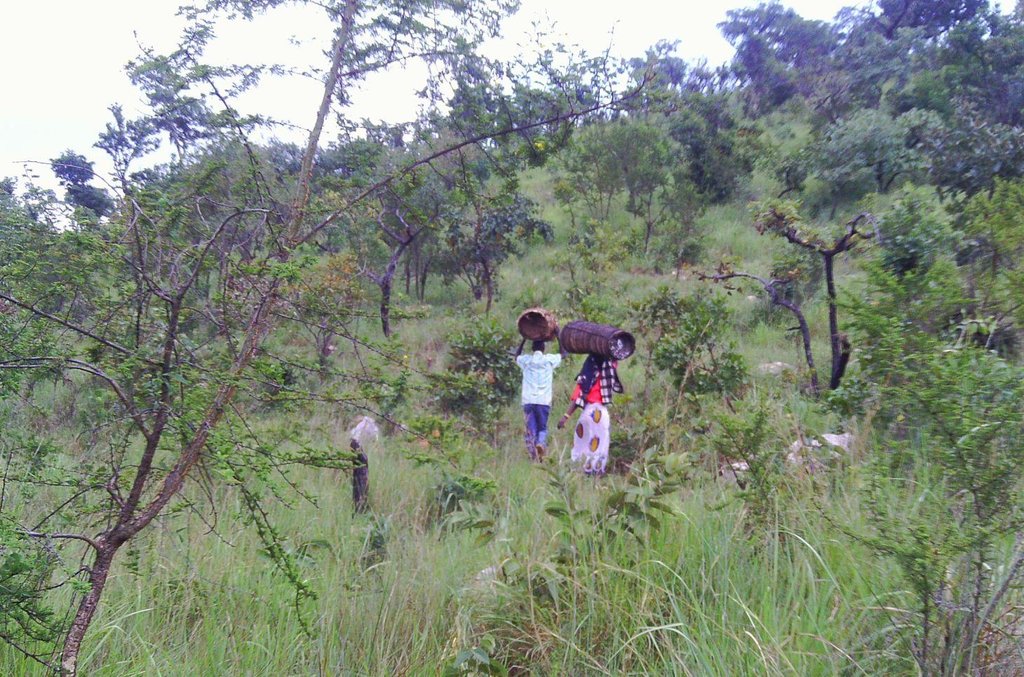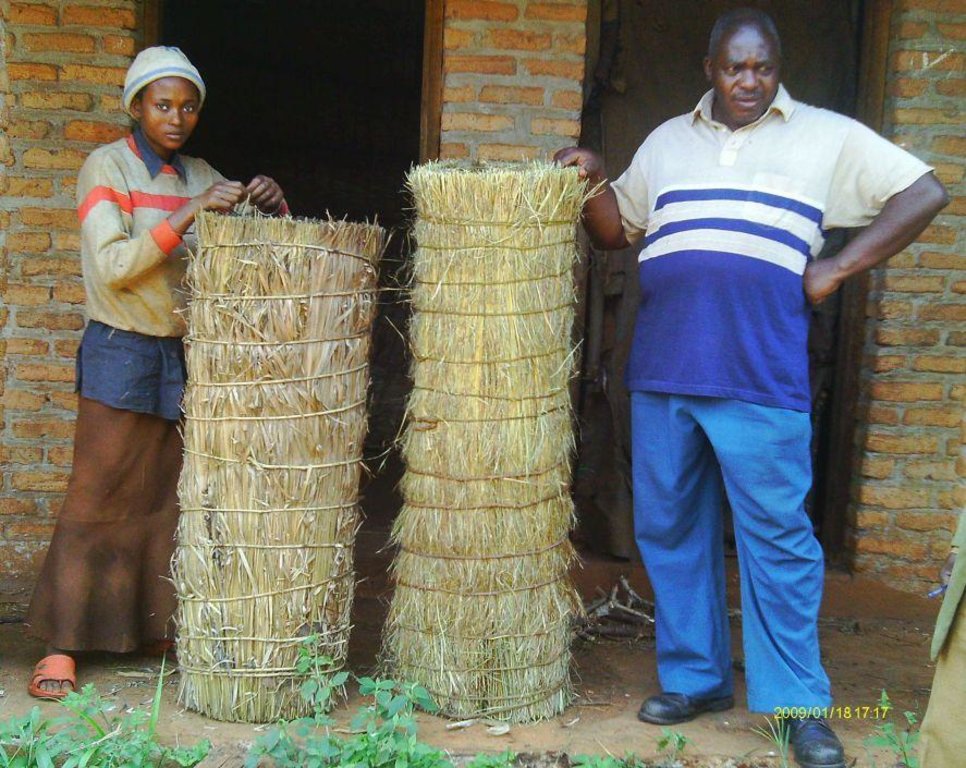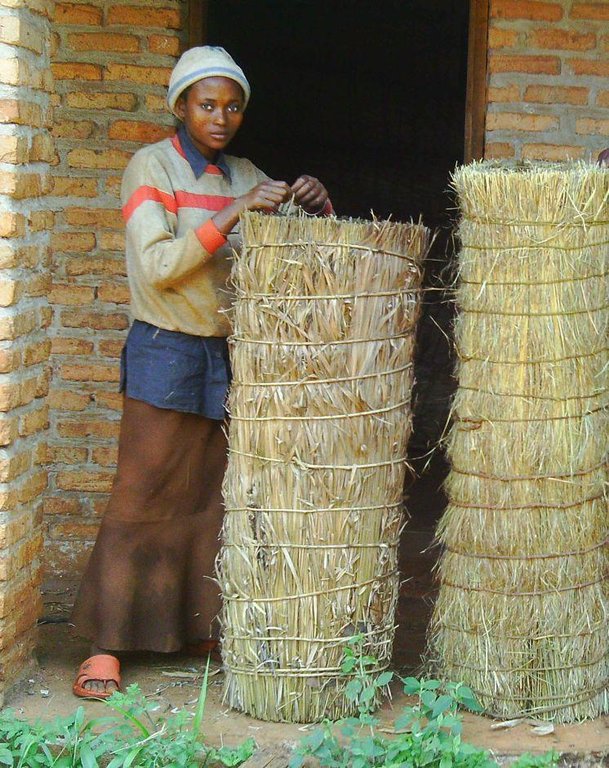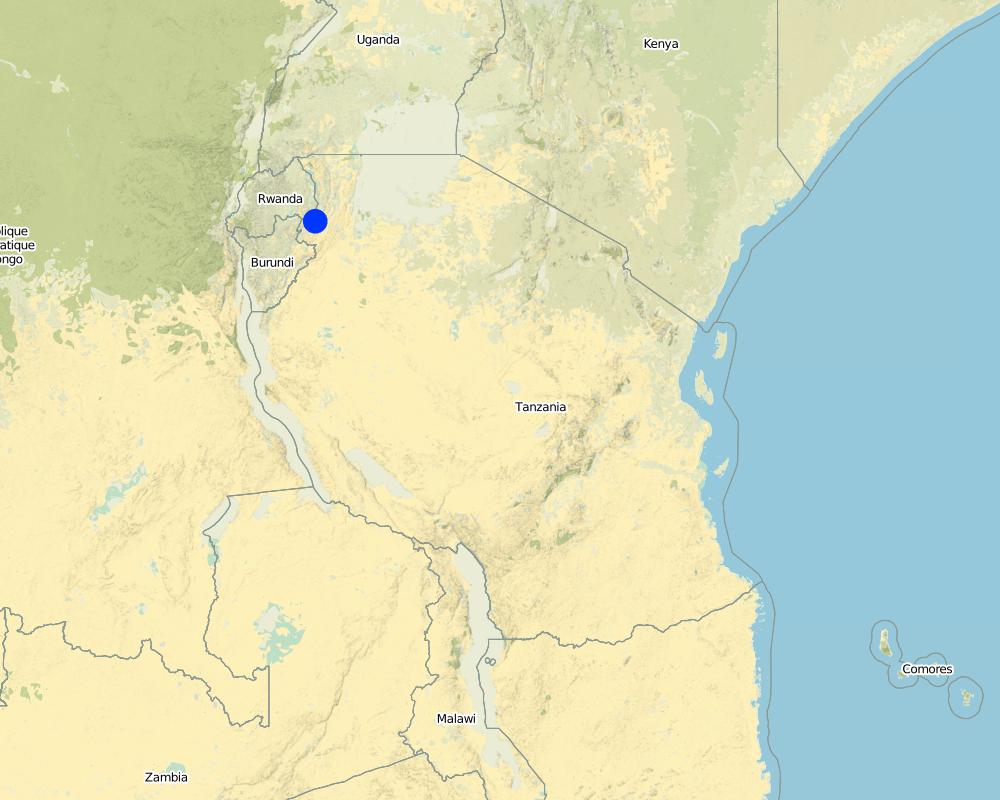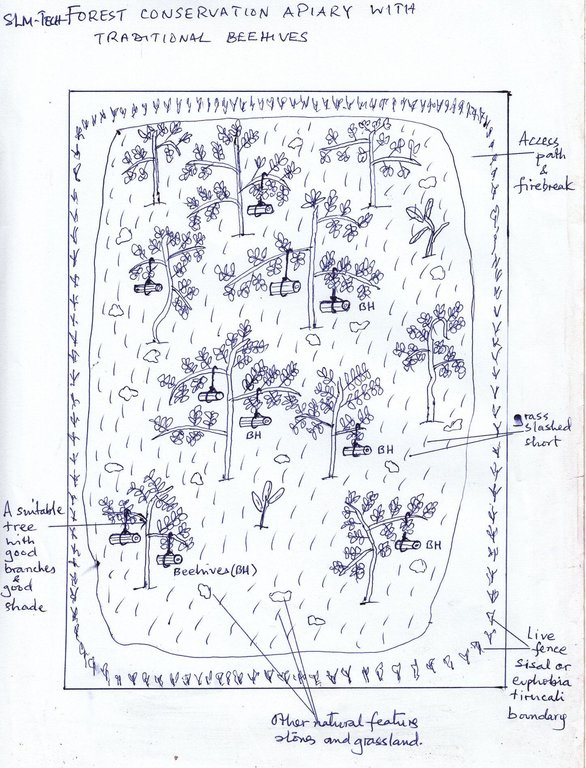Natural forest conservation using apiaries [تنزانيا، جمهورية تنزانيا المتحدة]
- تاريخ الإنشاء:
- تحديث:
- جامع المعلومات: Philip Ileta
- المحرر: –
- المراجعون: David Streiff, Alexandra Gavilano
Utunzaji misitu kwa kufuga nyuki (swahili),
technologies_1152 - تنزانيا، جمهورية تنزانيا المتحدة
عرض الأقسام
توسيع الكل طي الكل1. معلومات عامة
1.2 تفاصيل الاتصال بالأشخاص الرئيسيين لمصدر المعلومات والمؤسسات المشاركة في تقييم وتوثيق التقنية
متخصص في الإدارة المستدامة للأراضي:
Government:
Waluce Michael
Ngara District Council
تنزانيا، جمهورية تنزانيا المتحدة
Government:
Mugishagwe Wilson
Ngara District Council
تنزانيا، جمهورية تنزانيا المتحدة
Government:
Sangatati Josephat
Ngara District Council
تنزانيا، جمهورية تنزانيا المتحدة
متخصص في الإدارة المستدامة للأراضي:
Kaihura Fidelis
K-TAMP
تنزانيا، جمهورية تنزانيا المتحدة
اسم المشروع الذي سهّل توثيق/تقييم التقنية (إذا كان ذلك على صلة)
The Transboundary Agro-ecosystem Management Project for the Kagera River Basin (GEF-FAO / Kagera TAMP )اسم المؤسسة (المؤسسات) التي سهلت توثيق/تقييم التقنية (إذا كان ذلك على صلة)
Food and Agriculture Organization of the United Nations (FAO) - إيطاليااسم المؤسسة (المؤسسات) التي سهلت توثيق/تقييم التقنية (إذا كان ذلك على صلة)
Ngara District Council (Ngara District Council) - تنزانيا، جمهورية تنزانيا المتحدة1.3 الشروط المتعلقة باستخدام البيانات الموثقة من خلال WOCAT
يوافق جامع المعلومات والشخص (لاشخاص) الرئيسي لمصدر المعلومات على الشروط المتعلقة باستخدام البيانات الموثقة من خلال WOCAT:
نعم
1.5 الإشارة إلى الاستبيان (الاستبيانات) حول مناهج الإدارة المستدامة للأراضي (موثقة باستخدام WOCAT)
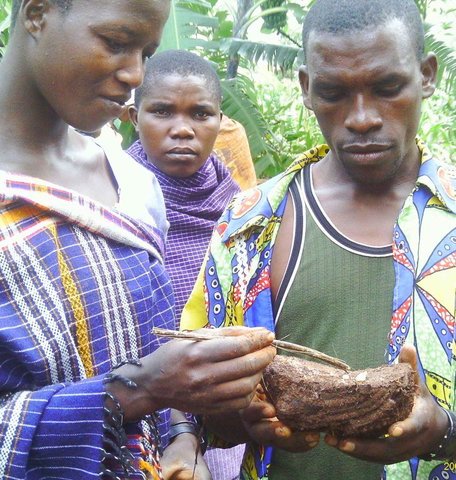
Community intergrated catchment ecosystem management [تنزانيا، جمهورية تنزانيا المتحدة]
Adaptive Agro-ecosystem Micro-catchment Approach.
- جامع المعلومات: ALLAN BUBELWA
2. وصف تقنيةالإدارة المستدامي للأراضي
2.1 وصف مختصر للتقنية
تعريف التقنية:
Establishment of apiaries in natural forests to retard forest mismanagement and improve honey production
2.2 وصف تفصيلي للتقنية
الوصف:
This technology has been practiced in Ngara region for the last 50 year and involves construction and upkeep of apiaries for honey and related goods production. The apiaries are constructed by farmers (traditional) or purchased (modern box hieves) and then positioned in a designated forest area that is away from settlements and public places. The apiaries should be hanged on a strong branches of trees with good shade and the honey production process takes from 9 to 12 months.
Purpose of the Technology: It is recommended to apply this technology in the forest that is exposed to deforestation as apiaries help to enhance forest protection. The establishment of apiaries help to improve management of the natural forest while increasing production of honey. This will contribute to the better livelihood of the community and environmental wellbeing.
Establishment / maintenance activities and inputs: The described technology covers area of enclosed 4 hectares of natural forest and establishment of 365 apiaries (338 traditional, 27 box hives); the group of practitioners consist of 10 members (7 male and 3 female). The establishment procedures require: a) identification of forest at risk of degradation, b) ermarcation of the apiary forest, c) creefing of fire breaks d) reparations for and hanging the beehives (traditional and box hives). Maintanance acivities include a) regular slashing of grasses and bushes around the trees with hives b)grading with hand hoes the fire breaks/ roads around the entire forest for fire protection before each dry season c) cleaning of hives,repairs and harvest honey with bee protectives (bee smoker,bee veils,gloves) to eliminate the risks of fire in the forest.Patrol and guard tresspassers d) monitoring pests and diseases
Natural / human environment: Natural occuring tree species include: Combretus spp., Albizia spp., Parinari spp., Pericopsis spp. and Eucalyptus woodlots. Grazing areas are nearby but restricted by village by laws to tress pass in the forest apiary
The aipiaries should be located near permanent water sources because bees use water for honey production and cooling in the hives. Farmers with bee hives become more committed to protect their forest when they hang beehives in the area. Honey is harvested for consumption, trade and medicinal mixtures
The land users are small scale subsistance farmers with poor to average income/wealth,organised as a group of 10 farmers. the population density is between 200-500 people per square km and anual population growth at 2-3% Land ownership is both individual and communal but there are natural forestl areas owned communally through village governments where groups may access temporarily by request to establish environmental friendly activities such as forest apiaries.
2.3 صور التقنية
2.5 البلد/المنطقة/المواقع التي تم تنفيذ التقنية فيها والتي يغطيها هذا التقييم
البلد:
تنزانيا، جمهورية تنزانيا المتحدة
المنطقة/الولاية/المحافظة:
Tanzania
مزيد من التفاصيل حول الموقع:
Ngara District
حدد انتشار التقنية:
- منتشرة بالتساوي على مساحة
إذا كانت المساحة الدقيقة غير معروفة، فيرجى الإشارة إلى المنطقة التقريبية المغطاة:
- < 0.1 كم2 (10 هكتار)
التعليقات:
The described technology covers area of enclosed 4 hectares of natural forest. Applied 365 bee hives (338 traditional, 27 box hives); the practitioners group has 10 members (7male and 3 female)
Map
×2.6 تاريخ التنفيذ
في حالة عدم معرفة السنة بالتحديد، يرجى الإشارة إلى التاريخ التقريبي:
- منذ أكثر من 50 عامًا (تقليدي)
2.7 إدخال التقنية
حدد كيف تم إدخال التقنية:
- كجزء من النظام التقليدي (> 50 عامًا)
التعليقات (نوع المشروع، الخ):
Beekeeping using local hives is a tradtional practice among the the Hangaza and Shubi ethinic tribes of Ngara district
3. تصنيف تقنية الإدارة المستدامي للأراضي
3.1 الغرض الرئيسي ( الأغراض الرئيسية) للتقنية
- حماية مستجمعات المياه / المناطق الواقعة في اتجاه مجرى النهر - مع تقنيات أخرى
- الحفاظ على/تحسين التنوع البيولوجي
3.2 نوع (أنواع) استخدام الأراضي الحالية حيث يتم تطبيق التقنية

الغابات/ الأراضي الحرجية
- Combretus spp., Albizia spp., Parinari spp., Pericopsis spp. and Eucalyptus woodlots
منتجات وخدمات:
- حطب الوقود
- منتجات الغابات الأخرى
- الرعي/ رعي أطراف الأشجار الفتية (الجلح)
- حفظ/حماية الطبيعة
التعليقات:
Major land use problems (compiler’s opinion): Deforestation and fire burning during dry season
Reduction of biodiversity
Major land use problems (land users’ perception): Droughts and vegetation burning during dry seasons
Problems / comments regarding forest use: the natural forest has been set aside for establishing bee apiaries therefore only forest managenet operation are conducted(slashing of grass)
3.4 إمدادات المياه
التعليقات:
Number of growing seasons per year:
2
Specify:
Longest growing period in days: 120; Longest growing period from month to month: Sept-December; Second longest growing period in days: 90; Second longest growing period from month to month: March to May
3.5 مجموعةالإدارة المستدامة للأراضي التي تنتمي إليها هذه التقنية
- إغلاق المنطقة (إيقاف الاستخدام، دعم الاصلاح)
- تربية النحل، واستزراع الأسماك، والدواجن، وتربية الأرانب، وتربية دودة القز، الخ.
3.6 التدابير التقنية في مجال إلادارة المستدامة للأراضي

التدابير الزراعية
- A7: أخرى

التدابير الإدارية
- M3: التخطيط وفقا للبيئة الطبيعية والبشرية
3.7 الأنواع الرئيسية من تدهور الأراضي التي تناولتها التقنية

التدهور البيولوجي
- (Bc): تناقص الغطاء النباتي
- (Bh): فقدان الموائل
- (Bq): انخفاض الكمية/الكتلة الحيوية
- (Bf): الآثار الضارة للحرائق
- (Bs): انخفاض جودة وتركيبة الأنواع/التنوع
التعليقات:
Main type of degradation addressed: Bc: reduction of vegetation cover, Bh: loss of habitats, Bq: quantity / biomass decline, Bf: detrimental effects of fires, Bs: quality and species composition /diversity decline
Main causes of degradation: deforestation / removal of natural vegetation (incl. forest fires) (Deforestation through cutting of trees), over-exploitation of vegetation for domestic use (Mainly for firewood), industrial activities and mining (Firewood for burning bricks made from clay), droughts, land tenure (Lack of village land use plans for the area), governance / institutional (Weak natural resources enforcent institution at village level)
Secondary causes of degradation: overgrazing
3.8 منع أو حد أو عكس تدهور الأراضي
تحديد هدف التقنية فيما يتعلق بتدهور الأراضي:
- منع تدهور الأراضي
- الحد من تدهور الأراضي
التعليقات:
Secondary goals: mitigation / reduction of land degradation
4. المواصفات الفنية، وأنشطة التنفيذ، والمدخلات، والتكاليف
4.1 الرسم الفني للتقنية
المواصفات الفنية (المتعلقة بالرسم الفني):
Layout of natural apriaries (beehives BH) placed on the trees (good braches with shade), access path and firebreak and live fence.
Ngara district Council
Date: 15 May 2012
Technical knowledge required for field staff / advisors: moderate (To extend knowledge/skills on modern/sustainable beekeeping)
Technical knowledge required for land users: moderate (To add/improve skills on existing indigineous knowledge)
Main technical functions: indirectly minimize deforestation, indirectly increase of biomass
Secondary technical functions: promotion of vegetation species and varieties (quality, eg palatable fodder), control of fires, reduction of dry material (fuel for wildfires), spatial arrangement and diversification of land use
Aligned: -along boundary
Vegetative material: O : other
Change of land use practices / intensity level: Establishment of bee apiaries in forest to add on value/productivity and optimise diversification of land use
Layout change according to natural and human environment: The site should be away at least 400m from nearby settlements/public places
Major change in timing of activities: Twice per year Feb and Sept during honey harvesting season management activities are at their peak.
- Fire breaks established in June /July before dry season commence
Control / change of species composition: Various flora and fauna organisms get time to establish and grow well due to absence of burning
المؤلف:
Ileta Philip, P.O BOX 30, Ngara
4.2 معلومات عامة بخصوص حساب المدخلات والتكاليف
حدد العملة المستخدمة لحساب التكاليف:
- دولار أمريكي USD
اذكر متوسط تكلفة أجر العمالة المستأجرة في اليوم الواحد:
1.25
4.3 أنشطة التأسيس
| النشاط | التوقيت (الموسم) | |
|---|---|---|
| 1. | Purchase of hives and binding wires | Before dry season |
| 2. | Purchase of beekeeping protectives | Routine |
| 3. | Slashing, screefing bushes and tall grasses; planting hedge around forest boundary | Before dry season |
| 4. | Baiting and hanging apiaries | Before dry season |
| 5. | Purhase of cuttings (euphobia spp) | wet season |
التعليقات:
FOREST CONSERVATION APIARIES technology REVISED PART-November 2013 Description and purpose This is a practice where farmers hang bee hives on branches of trees in the forest and keep the honey bees between six to twelve months whereby honey is already mature for harvesting. Conventional beekeeping methods have introduced other practices such as placing beehives on stands/platforms and keeping many hives in the shelter bee houses whereby honey production can be increased. The trees and forest where bee hives are hanged are normally respected and not felled indiscriminately.
Identification of suitable trees/forest Bees forage on nectar and pollen from flowers of many trees, herbs, shrubs and field plants. However there are specific plant species which are more preferred were bees visit more frequently. The forest or locality with rich biodiversity of the suitable trees/plants is conducive for establishment of a bee apiary. Prominent tree species in this zone include Parinari curatelifolia, Combretum spp, Brachtegia spp, Albizia spp, Acacia spp and cultivated crops such as banana, coffee, and annual crops which include maize, bean and sorghum The source of permanent water should be nearby preferably not more than 3kms because bees use much water in feeding, making honey and to perform cooling in the hives. Demarcation of the apiary forest It is usual for the beekeepers to demarcate the areas so as to inform and alert the community members the existence of the beehives. The demarcation signs may involve partially debarking part of the stem bark of the border trees. The use of colour paints, planting of hedge rows and other boundary marker plants are increasingly becoming popular around many forest apiaries. The common plants for live fence include Euphorbia tirucali, Agaves sisalana and Dovyalis caffra. Types of bee hives Common traditional beehives involve log hives, small poles/withies hives, straw hives, calabashes and clay pots. The use of modern box hives has increased in recent years mainly due to development projects support in modern beekeeping methods. Local hives are cheap but not durable limited to one to three years lifespan and the production is low compared with box hives which may last for ten or more years under good care. Preparations for hanging the beehives i) Bait materials Farmers utilize some materials to attract bee colonies establish in the hives. These include smoking or burning of dry honey combs and rubbing of beeswax inside the hives. Other methods involve sprinkling of either maize flour, cassava flour, raw honey or sugar. The use of many types of herbs and other less known substances(less revealed) to rub and smoke in the beehives before hanging is observed to be more effective in some communities. Some traditional beekeepers have become popular and earn money and respect through providing such services .The swarming periods which normally happen in January/Feb and Mid August/ Sept are suitable for hanging the beehives because it may not take long time to pocess the bee colonies ii) Ropes and tree climbing devices The hives has to be carried to the apiary and be hanged up on a tree branch. This may involve transporting the beehives using any transport means and carry on head load for some distance depending on accessibility and the location of the forest apiary. One or two person has to climb the tree and others remain on the ground to lift the hive. The hive is round bound with strong tree bark ropes before hanging The use of sisal ropes and binding wires have replaced the traditional methods to tie and fix the hives in modern beekeeping apiaries. A tall ladder may be helpful to assist in climbing of tall trees in case of aged individuals. The bee shelter house/huts and hive stands These are normally located in the forest apiary and constructed with local materials especially tree poles, straws and thatched on top roof with dry grass or other leafy vegetation such as banana, coconut and many others plants depending on availability. The hut walls are left open without covering the round walls with earth to facilitate cooling with the fresh air movements. The bee hives are placed on top of each other on the 1.2 m high erected tree poles stands. This practice enables to have many bee hives in one house which are easy to manage and protect provided the surrounding flora has good potential of bee forage plants. Water and sugars may be provided in special containers as extra feeds during bad weather conditions
4.4 التكاليف والمدخلات اللازمة للتأسيس
| تحديد المدخلات | الوحدة | الكمية | التكاليف لكل وحدة | إجمالي التكاليف لكل مدخل | % من التكاليف التي يتحملها مستخدمو الأراضي | |
|---|---|---|---|---|---|---|
| العمالة | Slashing, screefing bushes and tall grasses | persons/day | 100,0 | 0,63 | 63,0 | 100,0 |
| العمالة | Baiting and hanging apiaries | persons/day | 100,0 | 0,63 | 63,0 | 100,0 |
| معدات | Hives and binding wires | pieces | 400,0 | 2,25 | 900,0 | 50,0 |
| معدات | Beekeeping protectives | sets | 4,0 | 93,75 | 375,0 | 80,0 |
| المواد النباتية | Cuttings | bundles | 200,0 | 0,3 | 60,0 | 100,0 |
| إجمالي تكاليف إنشاء التقنية | 1461,0 | |||||
| إجمالي تكاليف إنشاء التقنية بالدولار الأمريكي | 1461,0 | |||||
التعليقات:
Duration of establishment phase: 2 month(s)
4.5 الصيانة/الأنشطة المتكررة
| النشاط | التوقيت/الوتيرة | |
|---|---|---|
| 1. | Slashing grasss,bushes and firebreaks | Before dry season |
| 2. | Apiaries repair | Regular |
| 3. | Monitoring of bee pests and diseases | Regular |
التعليقات:
Bush fire control This is done before the onset of the dry season by establishment of firebreaks around the apiary and slashing short the tall grass and other unwanted vegetation in the apiary forest. Cleaning, repairng and fixing the beehives The beehives that have become loose ,damaged or fallen due to strong winds, rains and disturbance by intruders or animals and birds requires replacement or renovations. In many cases pests such as ants, termites and rodents attack bees and make them abandon the hive. Such hives require repairs and cleaning inside before another bee colony can establish Honey harvesting. There is usually one major honey flow season starting May/June to Sept/October in most places, but another minor season may occur in February depending on the abundance of flowering in the previous season. Traditional honey harvesting equipments and tools include clay pots and other local containers, a hive knife and a smoking/burning grass appliance like torch to kill or scare away the bees. Modern beekeeping make use of special set of equipments and protective clothes that include an overall, a veil, a hat, a bee smoker, gloves, boots and hive tool. During harvesting the last two to three combs of honey are left in the hive to enable the colony continue to feed and resume manufacture honey for the following season Honey processing, packaging and marketing Raw honey is strained and filtered from the chopped honey combs through a clean linen or cotton cloth. The honey storage devices include plastic buckets, jerry cans and small (0.5 to 1 litre) plastic or glass bottles which sales between 2 to 4 US dollars at roadsides in the local market. Uses of honey The sweet and delicious fluid becomes ready for consumption or sale. There are many other uses which include brewing, medicine, in cosmetics, making candles and shoe shine pastes. Bees wax is obtained after boiling and cooling the filtered honey combs juice. Good quality raw honey should be light brown in colour, free from impurities such as any dirty, bee legs, wings and less pollen. Honey can be stored for many years due to its bactericidal and bacterial static properties. Boiled honey is of less quality, light in density, colour and loses most of its chemical and medicinal properties Philip Ngara Tanzania
4.6 التكاليف والمدخلات اللازمة للصيانة/للأنشطة المتكررة (سنويًا)
| تحديد المدخلات | الوحدة | الكمية | التكاليف لكل وحدة | إجمالي التكاليف لكل مدخل | % من التكاليف التي يتحملها مستخدمو الأراضي | |
|---|---|---|---|---|---|---|
| العمالة | Slashing grasss, bushes and firebreaks | persons/day | 60,0 | 1,25 | 75,0 | 100,0 |
| العمالة | Apiaries repair | persons/day | 20,0 | 0,8 | 16,0 | 100,0 |
| العمالة | Monitoring of bee pests and diseases | persons/day | 20,0 | 0,8 | 16,0 | 100,0 |
| إجمالي تكاليف صيانة التقنية | 107,0 | |||||
| إجمالي تكاليف صيانة التقنية بالدولار الأمريكي | 107,0 | |||||
التعليقات:
Machinery/ tools: Matchets,Slashers,Hoes,,Ropes,ladder for climbing trees.Binding wires
labour per hectare year 2011
tools per piece/each year 2011
4.7 أهم العوامل المؤثرة على التكاليف
قدم وصفا لأهم العوامل التي تؤثر على التكاليف:
High prices of equpipment an (especially box hives) and labour
5. البيئة الطبيعية والبشرية
5.1 المناخ
هطول الأمطار السنوي
- < 250 مم
- 251- 500 ملم
- 501 - 750ملم
- 1,000-751 ملم
- 1,500-1,100 ملم
- 2,000-1,500 ملم
- 3,000-2,001 ملم
- 4,000-3,100 ملم
- > 4000 ملم
المواصفات/التعليقات على هطول الأمطار:
Bimodal-(sept to december)and Feb to May/June
المنطقة المناخية الزراعية
- شبه رطبة
Thermal climate class: tropics. Hot months(June,July,August,September),cold months(March,April),cool months(May,October)
5.2 طوبوغرافيا
متوسط الانحدارات:
- مسطح (0-2%)
- بسيط (3-5%)
- معتدل (6-10%)
- متدحرج (11-15%)
- تلال (16-30%)
- شديدة الانحدار(31-60%)
- فائقة الانحدار (>60%)
التضاريس:
- هضاب/سهول
- أثلام مرتفعة
- المنحدرات الجبلية
- منحدرات التلال
- منحدرات في السفوح
- قاع الوادي
المنطقة الارتفاعية:
- 100-0 متر فوق سطح البحر
- 500-101 متر فوق سطح البحر
- 1,000-501 متر فوق سطح البحر
- 1,500-1,001 متر فوق سطح البحر
- 2,000-1,501 متر فوق سطح البحر
- 2,500-2,100 متر فوق سطح البحر
- 3,000-2,501 متر فوق سطح البحر
- 4,000-3,001 متر فوق سطح البحر
- > 4000 متر فوق سطح البحر
التعليقات والمواصفات الإضافية بشأن التضاريس:
Slopes on average: The technology is not affected with slope variations
Landforms: The site of the forest apiary is located on hill slopes
5.3 التربة
متوسط عمق التربة:
- ضحل جدًا (0-20 سم)
- ضحلة (21-50 سم)
- متوسطة العمق (51-80 سم)
- عميقة (81-120 سم)
- عميقة جدًا (> 120 سم)
قوام التربة (التربة السطحية):
- متوسط ( طميي، سلتي)
المواد العضوية في التربة السطحية:
- متوسطة (1-3%)
إذا كان متاحًا، قم بإرفاق وصف كامل للتربة أو تحديد المعلومات المتوفرة، على سبيل المثال نوع التربة، الرقم الهيدروجيني/ درجة حموضة التربة، قدرة التبادل الكاتيوني، النيتروجين، الملوحة وما إلى ذلك.
Soil depth on average: The depth of soil affects the vigour of grass,trees and other vegetation thus amount of biomass available for fire threat during fire season,the labour required for maintanance etc
Soil fertility is medium
Soil drainage / infiltration is medium
Soil water storage capacity is medium
5.4 توافر المياه ونوعيتها
منسوب المياه الجوفية:
> 50 م
توافر المياه السطحية:
جيد
نوعية المياه (غير المعالجة):
مياه شرب جيدة
تعليقات ومواصفات أخرى بشأن نوعية المياه وكميتها:
Ground water table: On hill slopes
Water quality (untreated): The site for good drinking water is located some 400m proximal to the natural spring water source used for domestic supply and the Ruvuvu river is not far approximatle 2.kms. Poor drinking water at valley bottoms and wetlands nearby (4kms) and water for agricultural use only in wetlands, is used seasonally for dry season agriculture
5.5 التنوع البيولوجي
تنوع الأنواع:
- متوسط
التعليقات والمواصفات الإضافية بشأن التنوع البيولوجي:
Degraded mostly by fire,overcutting of trees for firewood
5.6 خصائص مستخدمي الأراضي الذين يطبقون التقنية
التوجه السوقي لنظام الإنتاج:
- الكفاف (الإمداد الذاتي)
- مختلط (كفاف/ تجاري)
الدخل من خارج المزرعة:
- أقل من % 10من كامل الدخل
المستوى النسبي للثروة:
- ضعيف
- متوسط
أفراداً أو مجموعات:
- المجموعات/ المجتمع المحلي
الجنس:
- رجال
اذكر الخصائص الأخرى ذات الصلة لمستخدمي الأراضي:
Land users applying the Technology are mainly common / average land users
Difference in the involvement of women and men: -Very few women were invoved trditionally-due to climbing of trees to hang bee hives and honey harvesting.These are activities usually performed by men
-Women perform slashing of grass, processing of honey and marketing of products
Population density: 100-200 persons/km2
Annual population growth: 2% - 3%; 3%
20% of the land users are average wealthy and own 50% of the land.
80% of the land users are poor and own 50% of the land.
Off-farm income specification: A small number of people practice off farm activities in burnt bricks making and petty trade
Market orientation of production system: Honey for market, very little for consumption
5.7 متوسط مساحة الأرض التي يستخدمها مستخدمو الأراضي الذين يطبقون التقنية
- < 0.5 هكتارا
- 0.5 - 1 هكتار
- 1 -2 هكتار
- 2 - 5 هكتار
- 5 - 15 هكتار
- 15 - 50 هكتار
- 50 - 100هكتار
- 500-100 هكتار
- 1,000-500 هكتار
- 10,000-1,000 هكتار
- > 10,000 هكتار
هل يعتبر هذا نطاقًا صغيرًا أو متوسطًا أو واسعا (في إشارة إلى السياق المحلي)؟:
- على نطاق صغير
التعليقات:
Average area of land owned or leased by land users applying the Technology: Also 1-2 ha
The population density is low with a large ares of forests(55% of total area) still marginally disturbed
5.8 ملكية الأراضي، وحقوق استخدام الأراضي، وحقوق استخدام المياه
ملكية الارض:
- مجتمعي/قروي
- لمجموعة
حقوق استخدام الأراضي:
- مجتمعي (منظم)
التعليقات:
The group was allocated the forest area of approximately 4 ha by village govt to establish the forest apiary.
5.9 الوصول إلى الخدمات والبنية التحتية
الصحة:
- ضعيف
- معتدل
- جيد
التعليم:
- ضعيف
- معتدل
- جيد
المساعدة التقنية:
- ضعيف
- معتدل
- جيد
العمل (على سبيل المثال خارج المزرعة):
- ضعيف
- معتدل
- جيد
الأسواق:
- ضعيف
- معتدل
- جيد
الطاقة:
- ضعيف
- معتدل
- جيد
الطرق والنقل:
- ضعيف
- معتدل
- جيد
مياه الشرب وخدمات الصرف الصحي:
- ضعيف
- معتدل
- جيد
الخدمات المالية:
- ضعيف
- معتدل
- جيد
6. الآثار والتصريحات الختامية
6.1 الآثار التي أظهرتها التقنية في الموقع
الآثار الاجتماعية والاقتصادية
الإنتاج
إنتاج المحاصيل
إنتاج الخشب
التعليقات/ حدد:
Trees not scotched by fire,trees growing smoothly
خطر فشل الإنتاج
تنوع المنتج
منطقة الإنتاج
التعليقات/ حدد:
Increased productivity per area of forest
توليد الطاقة
التعليقات/ حدد:
Retention of permanent vegetation cover
الدخل والتكاليف
دخل المزرعة
التعليقات/ حدد:
Increased opportunities for crop pollination in nearby fields
تنوع مصادر الدخل
التعليقات/ حدد:
Honey and beeswax primary products for sale from apiary
الآثار الاجتماعية والثقافية
الأمن الغذائي / الاكتفاء الذاتي
التعليقات/ حدد:
Sale of bee products during good harvest to contribute to household income
الوضع الصحي
التعليقات/ حدد:
Honey demand in herbal mixtures for diseases cure
الفرص الثقافية
التعليقات/ حدد:
Reduce fire incidences
الفرص الترفيهية
التعليقات/ حدد:
The forest is beautiful to visit
المؤسسات المجتمعية
التعليقات/ حدد:
Group cohesion due to common interests/income opportunities
المعرفة بالإدارة المستدامة للأراضي/تدهور الأراضي
التخفيف من حدة الصراع
livelihood and human well-being
التعليقات/ حدد:
Increased income for the group members through sale of bee products honey as food and for diseases treatments members have attended various training for forest management and modern beekeeping members have incresed access to loans and credit organisations
dangers of bee attack
التعليقات/ حدد:
When tresspassing people and animals or during swarming and harvesting honey
الآثار الايكولوجية
دورة المياه / الجريان السطحي
كمية المياه
الجريان السطحي
التعليقات/ حدد:
Retention of permanent vegetation cover
التبخر
التعليقات/ حدد:
Retention of permanent vegetation cover
التربة
رطوبة التربة
التعليقات/ حدد:
Retention of permanent vegetation cover
غطاء التربة
التعليقات/ حدد:
Retention of permanent vegetation cover
فقدان التربة
التعليقات/ حدد:
Retention of permanent vegetation cover
تراص التربة
التنوع البيولوجي: الغطاء النباتي، الحيوانات
الكتلة الحيوية/ طبقة الكربون فوق التربة
التعليقات/ حدد:
Retention of permanent vegetation cover
التنوع النباتي
الأنواع المفيدة
التعليقات/ حدد:
Retention of permanent vegetation cover
تنوع الموائل
التعليقات/ حدد:
Retention of permanent vegetation cover
الحد من مخاطر المناخ والكوارث
انبعاث الكربون والغازات المسببة للاحتباس الحراري
خطر الحريق
التعليقات/ حدد:
Retention of permanent vegetation cover
سرعة الرياح
التعليقات/ حدد:
Retention of permanent vegetation cover
الآثار الايكولوجية الأخرى
pollination of forest and crops
6.3 تعرض التقنية وحساسيتها لتغير المناخ التدريجي والظواهر المتطرفة/الكوارث المرتبطة بالمناخ (كما يراها مستخدمو الأراضي)
تغير مناخ تدريجي
تغير مناخ تدريجي
| الموسم | زيادة أو نقصان | كيف تتعامل التقنية مع ذلك؟ | |
|---|---|---|---|
| درجة الحرارة السنوية | زيادة | ليس جيدا |
الظواهر المتطرفة / الكوارث المرتبطة بالمناخ
الكوارث المناخية
| كيف تتعامل التقنية مع ذلك؟ | |
|---|---|
| جفاف | ليس جيدا |
التعليقات:
By planting fire tolerant plant species around boundaries of the forest, beehives will be more secure from fire damage and the forest apiary remain with vegetative soil cover -such species includes agaves sisalana,euphobia tirucali etc
6.4 تحليل التكلفة والعائد
كيف يمكن مقارنة العوائد نسبة لتكاليف الإنشاء (من وجهة نظر مستخدمي الأراضي)؟
عوائد قصيرة الأجل:
سلبي قليلا
عوائد طويلة الأجل:
إيجابي
كيف تتم مقارنة العوائدمع كلفة الصيانة/التكاليف المتكررة (من وجهة نظر مستخدمي الأراضي)؟
عوائد قصيرة الأجل:
إيجابي
عوائد طويلة الأجل:
إيجابي
التعليقات:
After initial high establishment costs,maintanance costs are minimal and the box hives are durable for at least 10 years when made from durable well seasoned timber
6.5 اعتماد التقنية
- > 50%
إذا كان متاحًا، قم بتحديد الكمية (عدد الأسر المعيشية و/أو المساحةالمغطاة):
32 households in an area of 10 ha
من بين جميع الذين تبنوا التقنية، كم عدد الذين فعلوا ذلك بشكل تلقائي، أي دون تلقي أي حوافز مادية/مدفوعات؟:
- 11-50%
التعليقات:
17 land user families have adopted the Technology with external material support
Comments on acceptance with external material support: The box hives and beekeeping protectives were subsidies from projects/programmes under NGOs and governemnt support
50% of land user families have adopted the Technology without any external material support
15 land user families have adopted the Technology without any external material support
Comments on spontaneous adoption: Traditional beekeepeing with indigineous knowledge used traditional hives only.Government and some NGO s support improved by availing box hives and modern beekeeping knowledge
Comments on adoption trend: more 4 groups emerging who request for support n the area
6.7 نقاط القوة / المزايا / الفرص التي توفرها التقنية
| نقاط القوة/ المزايا/ الفرص من وجهة نظر مستخدمي الأراضي |
|---|
|
Increased income and income sources for farmers How can they be sustained / enhanced? Intergrate modern box hives, processing gears and improve markets for bee products. |
|
Decreased bushfire incidences How can they be sustained / enhanced? Strengthern bylaws administration procedures to punish persons causing bushfires, harvest honey in late evening and during the nights.Use beesmokers during harvesting |
| نقاط القوة/ المزايا/ الفرص من وجهة نظر جامع المعلومات أو غيره من الاشخاص الرئيسيين لمصدر المعلومات |
|---|
|
Enhanced forest conservation How can they be sustained / enhanced? Improve management/tending activities in the forest and administation of bylaws |
|
Improved vegetation cover How can they be sustained / enhanced? Enrichment planting with suitable bee forage plant species |
|
Incresed income and divesification of income sources How can they be sustained / enhanced? Intergrate modern beekeeping and improved processing of bee products.Construct beehives shelter house in the forest to accomodate more hives |
|
Decrease bush/grassfire incidences How can they be sustained / enhanced? Screefing firebreaks using hand hoes, conduct regular firepatrols during dry season,use proper honey harvesting equipments especially beesmokers. Environmental education and campaigns |
|
Continuous production of honey for consumption,sale and medicine How can they be sustained / enhanced? Reservation of more forests for practicing cormecial beekeeping |
6.8 نقاط ضعف / مساوىء / مخاطر التقنية وسبل التغلب عليها
| نقاط الضعف/ المساوىء/ المخاطر من وجهة نظر مستخدم الأراضي | كيف يمكن التغلب عليها؟ |
|---|---|
| Bee stings for people and livestock | Use of bee protective gears during honey harvesting |
| Regular conflicts with grazing of livestock in the forest during dry season when grass in other areas are already burned-Damaging of beehives by pastoralists | By laws administration and operational |
| نقاط الضعف/ المساوىء/ المخاطر من وجهة نظر جامع المعلومات أو غيره من الاشخاص الرئيسيين لمصدر المعلومات | كيف يمكن التغلب عليها؟ |
|---|---|
| High costs for box hives and bee protective gears | Intergrate modern box hives with durable traditional hives |
| Require large/extensive aeas/Competing demands especially firewood for energy domestic use/trade and grazing land areas |
By laws administration,Planting trees/woodlots have participatory and operational village land use plans |
| Bee stings for people and livestock | establish forest apiaries away(>400m) from human settlements and public places |
| Danger of falling from trees during hanging of hives and harvesting | Use ropes,ladder and tree climbing devises, |
7. المراجع والروابط
7.3 روابط للمعلومات ذات الصلة على الإنترنت
العنوان/الوصف:
Kagera TAMP Project website
عنوان الرابط URL:
http://www.fao.org/nr/kagera/en/
الروابط والوحدات المواضيعية
توسيع الكل طي الكلالروابط

Community intergrated catchment ecosystem management [تنزانيا، جمهورية تنزانيا المتحدة]
Adaptive Agro-ecosystem Micro-catchment Approach.
- جامع المعلومات: ALLAN BUBELWA
الوحدات المواضيعية
لا يوجد وحدات مواضيعية


